The Artisans Cup featured several panels throughout the weekend that gave visitors a chance to learn from the team that put the event together, from the Neils, and from the judges. During the judges’ panel, time was devoted to the different approaches of recognizing excellence in an exhibit.
The Artisans Cup recognized the 1st, 2nd and 3rd highest scoring trees regardless of size or variety (see “The Results are in!” for details). This approach takes a cue from Kokufu-ten in which judges recognize excellence without regard to tree size or variety. Unlike Kokufu, the Cup distinguished 1st place from 2nd and 3rd (Kokufu prizes share equal weight).
What’s great about this approach is that it produces a “winner” – an unambiguous best tree in the exhibit. This encourages competition and helps demonstrate excellence across categories. I also think it’s good as it encourages people to exhibit their very best trees, not their best trees within a given category.
That said, there are some great reasons to recognize trees by category too. This approach can encourage people to show different sizes and styles of trees which may lead to a more diverse show. It’s educational as we end up with exemplars in different categories – good for contrasting the characteristics we care about in deciduous varieties with those we look for in coniferous varieties.
With a strict category system, there’s no way to recognize a single “best in show.” It’s also tricky to handle situations where only a few trees appear in each category. If there are only two medium deciduous trees in an exhibit, is that enough competition to clearly award a winner? What if there is only one medium deciduous tree, but it’s the best tree in the exhibit?
The approach taken by the Taikan-ten and Sakufu-ten exhibits is to recognize the best tree in each category and award the honor of “best in show” separately. I think it’s a nice balance, though this too can be awkward in that the “best large conifer” is not as good as a large conifer that wins “best in show.”
Back in Oregon, we have the scores for all trees exhibited at the Artisans Cup and can recognize the best trees in each category after the fact. Using Dan Yamins’ normalized scores, I’ve indicated the trees with the highest average scores in several categories below. They’re all beautiful – I hope you enjoy them!
Best in Show – Randy Knight.

Rocky Mountain juniper
Best Large Conifer – Eric Schikowski.
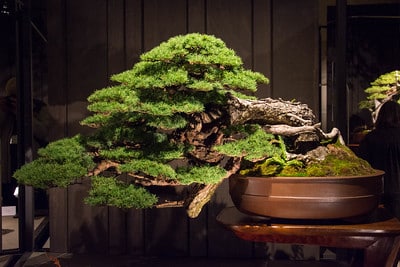
Mountain hemlock
Best Large Deciduous – Pacific Bonsai Museum.
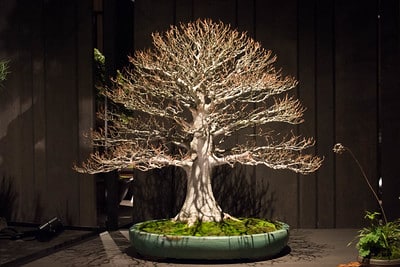
Japanese beech
Best Medium Deciduous – William N. Valavanis.
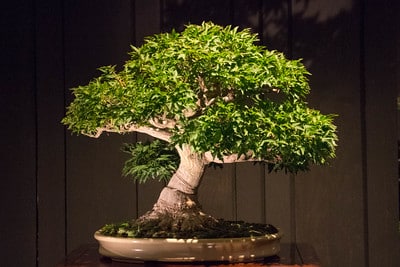
Japanese maple ‘Shishigashira’
Best Medium Conifer – Jason Eider.
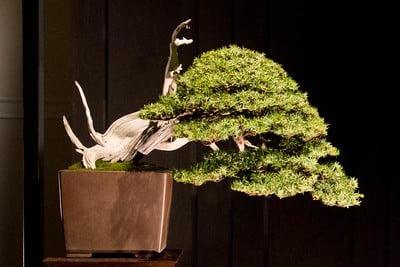
Needle juniper
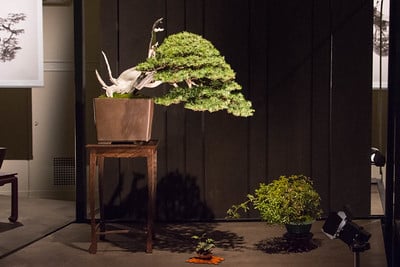
As displayed with rose and fern
Subscribe to Bonsai Tonight
New Posts Delivered Every Tuesday and Friday
N Elizabeth Johansen says
Why yes, I have taken advantage of events where items are judged by category. More often then not this is the system being used at state and county fairs where the best of category may well be the only entrant in that category. Entering as many categories as possible to increase the chances of going home with a ribbon is not only a given, but encouraged to insure lots of entries. The pitfall is that someone who is entering an item stock from the store might get the same rating as someone who put a lot of time and effort into their entry. There is a way to ovoid this, and that is by judging each item on it’s own merit, and having only one best of show. Yes, we can still have our over all winners. Judging on merit in the case of bonsai would ensure that someone doesn’t enter nursery stock hoping to be the only entrant in the category. If something isn’t worthy of recognition, it should not be given recognition, and giving praise where it is not earned hurts the repetition of the event. Another way to avoid a lack of entries in a given category is to avoid specialized categorizes, having only broad categorizes instead. I also feel that the most important consideration behind the use of categories is the size of the event. A small event would by nature have its limits, but the larger the event, the greater the potential diversity.
leebates says
I like the categories. Without categories, a large collected conifer will win every time — styled originally by mother nature and the 4 seasons.
thomdec says
Great post, Jonas. The Japanese beech is one of my favorites.
GoddessAakasha says
Beautiful